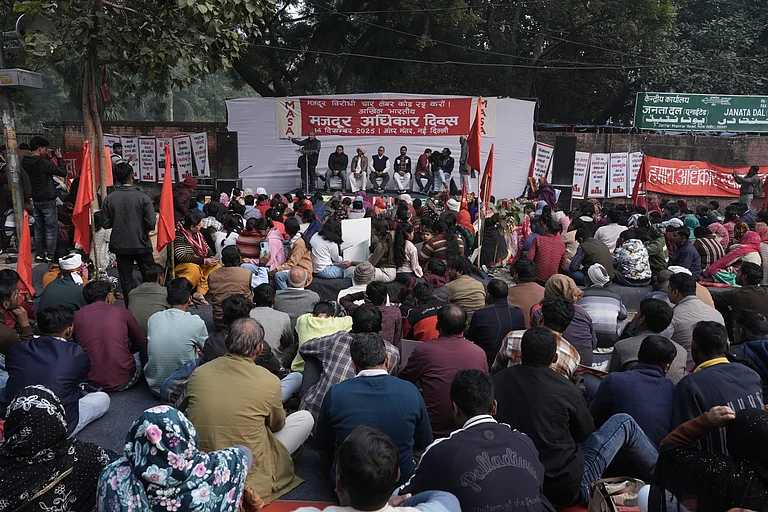The labour income share is declining globally, particularly due to technological advancements such as the adoption of artificial intelligence (AI), according to the September 2024 update of the World Employment and Social Outlook (WESO) report of the International Labour Organisation.
Labour income share is the proportion of total national income of a country earned by employed people. The ILO in its report states that the figure, which is a measure of inequality, has been steadily shrinking over the past 20 years, and the rise of AI and other technological changes are a big reason for this.
While global labour income declined by 1.6 percentage points in the past two decades, it went down by .6 percentage points between 2019 and 2022 alone— the time period during which AI came to the fore. The total annual loss of income is estimated to be $2.4 trillion in 2024 alone, with 2004 as the base. One of the most significant factors driving the decline in the labour income share, the report notes, is automation.
While automation has boosted both labour productivity and economic outlook across various sectors in many countries, including India, the technology has also resulted in less income going to human labour.
The WESO report suggests that as Generative AI advances and is increasingly adopted into businesses, the trend of reduced global labour income will continue; and may even accelerate as Large Language Models such as ChatGPT become more advanced.
The report is careful to point out that this is not a prediction about the inevitable impacts of AI. Rather, it highlights the possibility that, if current patterns persist without strong policy interventions, AI-driven technological change could result in further downward pressure on wages and incomes of workers globally.
The WESO report looked at data from 36 economies which have mostly adopted AI in various industries over the past 20 years. The report showed that technology-driven productivity growth does not give rise to proportional wage increases for human labour.
Since 2004, labour productivity has increased by 58 per cent globally , but labour income per hour worked has only risen by 53 per cent.
Furthermore, the report discusses the wide range of possible outcomes AI could have on economic growth. Some studies suggest that AI could have negligible effects, while others posit that it could double the global GDP growth rate. This uncertainty underscores the need for cautious optimism and a focus on ensuring that the gains from AI-driven productivity are distributed fairly across society.
The report also underscores that the decline in labour income share is not a given outcome of technological change. Policy responses will play a crucial role in shaping the future impact of AI on global economies. Governments need to implement measures that can mitigate the potential negative consequences of AI on labour markets, particularly for lower-income workers. Without such interventions, AI could worsen existing inequalities by further shifting income from labour to capital.
White Collar Jobs Most Affected by AI
In its Working Paper 96, published August last year, the ILO suggests that white-collar jobs will be the most exposed to AI-based disruption. Around 24 per cent of such work, 95 million jobs of the 400 million white collar jobs available globally, will see “significant task automation”. Out of these, ILO estimates 58 per cent, or 232 million jobs, will be only “moderately exposed” to AI; this means only some level of task automation will occur, but it won’t be too extensive. Among examples given by ILO are clerical and administrative roles such as data processing, book-keeping, accounting, and customer service representatives (call centres agents etc.)
Outside of the white collar jobs, the paper suggests that only one to four per cent of the jobs will be affected by AI. While this sounds like a small number, there are globally around three billion people in the workforce; thus, AI would affect around 33 to 132 million jobs in the blue-collar/ non-white-collar industries.
Experts remain divided on the ILO’s view, with some saying AI-adoption will potentially lead to new jobs being created to off-set some of the losses of work due to automation.
AI’s potential to automate repetitive tasks could lead to “freeing up human workers to focus on higher-value, more complex activities. This could mean a shift in the types of skills needed and the nature of certain jobs, particularly in white-collar sectors,” says award-winning technology journalist Pranav Dixit. However, Dixit also adds, “AI can also drive job creation in areas like data science and AI ethics, which are all emerging fields that require human expertise.”
However, Saurabh Bhattacharjee, Associate Professor, HAL Chair, at the National Law School (NLU) and a co-director for the Centre of Labour Studies, points out that a similar situation had come up for the West during the era of globalisation. “In the West, the new jobs that were created by globalisation and out-sourcing were largely high-skill work, and the lower-wage workers did not find any equivalent new jobs, and I think something similar will happen in India, and we need to be worried about this,” says Bhattacharjee.
To deal with the possible mass lay-offs resulting from AI-adoption, Bhattacharjee says, “We strengthen social security protection and may have to move towards a Universal Basic Income;” however he adds that “that brings in separate challenges.”
Women More Likely to Lose Jobs Than Men
According to the ILO’s study, women are more likely to lose jobs to, or have their jobs affected by, AI in High Income Countries (HIC). This is because women make up a large portion of staff doing clerical and administrative jobs.
ILO estimated that 7.8 per cent of HIC’s women workers will see their jobs affected by AI, whereas only 2.9 per cent of men will see any significant change in theirs. This number is less for Low Income Countries where only 3.7 per cent of women will find their jobs affected by AI. However, it is still double the number of men whose jobs will be exposed to AI—1.4 per cent.
This means, the ILO points out, that women are going to be disproportionately affected by AI, with millions of women needing to adapt and learn new skills to stay in the workforce.
“In an Indian context, especially, that women are uniquely vulnerable to being impacted by AI since they're often in roles that involve a lot of clerical and administrative work, which are highly susceptible to automation,” says Dixit.
Dixit suggests the way forward is by “creating an environment where women aren’t just coping with the changes AI brings but are empowered to lead and thrive in this new landscape.”
Policy measures, he says, could include “prioritising up-skilling programs that specifically target women, especially in tech and digital skills. Ensuring equal access to AI-based work will also be an important measure to take, he adds. “Encouraging more women to enter fields like data science, AI ethics, and tech development can not only diversify the workforce but also help shape how these technologies are used in ways that benefit everyone,” he says.
Developed Countries More Likely to be Impacted
In what may be considered somewhat a reversal from the industrial revolution, the AI revolution will likely affect HIC much more than LICs, says ILO. This is because HIC have more administrative and clerical jobs. For example, 5.5 per cent of HIC’s total jobs are exposed to potential automation by AI. This is roughly 14 million jobs.
In contrast, in LICs, jobs are not as exposed to AI automation, and require human intervention. As such, only 0.4 per cent of the workforce will be affected; this is about one million jobs.
The ILO, in conclusion, has said that while work that requires human creativity will be mostly unaffected by AI, countries should start bringing in policies and laws to protect such work.
Way Forward
Experts say policy around AI must be formed early to avoid “regulatory capture” by big IT companies and platform aggregators.
While historically the law has caught up with technological changes, Bhattacharjee points out that, “if the basic regulatory framework is not put in place too early then we will have regulatory capture, and the regulations will be framed by major IT behemoths and other companies which have a vested interest and that may militate against any form of transparent, consultative regulation on this, and that would be a tragedy for us.”


























